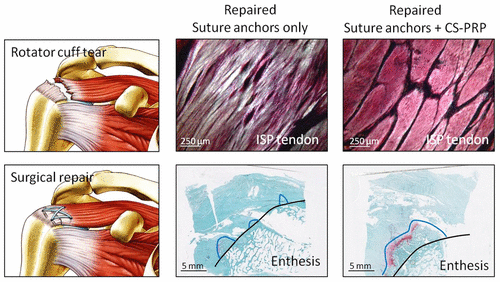当前位置:
X-MOL 学术
›
ACS Biomater. Sci. Eng.
›
论文详情
Our official English website, www.x-mol.net, welcomes your
feedback! (Note: you will need to create a separate account there.)
Freeze-Dried Chitosan-Platelet-Rich Plasma Implants for Rotator Cuff Tear Repair: Pilot Ovine Studies
ACS Biomaterials Science & Engineering ( IF 5.4 ) Pub Date : 2017-10-31 00:00:00 , DOI: 10.1021/acsbiomaterials.7b00354 Gabrielle Deprés-Tremblay , Anik Chevrier , Mark B Hurtig 1 , Martyn Snow 2 , Scott Rodeo 3 , Michael D Buschmann
ACS Biomaterials Science & Engineering ( IF 5.4 ) Pub Date : 2017-10-31 00:00:00 , DOI: 10.1021/acsbiomaterials.7b00354 Gabrielle Deprés-Tremblay , Anik Chevrier , Mark B Hurtig 1 , Martyn Snow 2 , Scott Rodeo 3 , Michael D Buschmann
Affiliation

|
Rotator cuff tears are a very common shoulder pathology. Different suturing techniques have been used for surgical cuff repair, but failure of healing remains a significant clinical challenge. The objective of this study was to establish and compare chronic and acute ovine rotator cuff tear models in our laboratory and investigate the feasibility of using chitosan (CS)-platelet-rich plasma (PRP) implants in conjunction with suture anchors to treat rotator cuff tears in large animal models. Repair with suture anchors only was used as control. In two preliminary pilot studies, unilateral full-thickness tears were created in the infraspinatus (ISP) tendon of mature female Texel-cross sheep. In the chronic model (n = 4 sheep), the tendons were capped with silicon and allowed to retract for 6 weeks, leading to degenerative changes, whereas the tendons were immediately repaired in the acute model (n = 4 sheep). Transected ISP tendons were reattached with suture anchors and, in the case of treated shoulders, implants composed of freeze-dried CS solubilized in autologous PRP were additionally applied to the tendon–bone interface and on top of the repaired site. The chronic defect model induced significant tendon degeneration and retraction, which made repair more challenging than in the acute defect model. Half the tendons in the chronic repair model were found to be irrepairable at 6 weeks. In the other half, the tendons could not be reattached to the footprint due to significant retraction, which made this a model of tissue formation in a gap. In contrast, the acute tendon repair model was executed easily. Extensive bone remodeling and tissue ingrowth at the tendon-bone interface were observed in the case of treatment with anchors + CS-PRP in both models, suggesting that CS-PRP implants could potentially modulate rotator cuff healing processes in large animal models.
中文翻译:

冷冻干燥的壳聚糖-富含血小板的等离子植入物用于肩袖撕裂修复:绵羊试验研究
肩袖撕裂是一种非常常见的肩部病理。已经将不同的缝合技术用于袖套的手术修复,但是愈合失败仍然是重大的临床挑战。这项研究的目的是在我们的实验室中建立和比较慢性和急性绵羊肩袖撕裂模型,并研究结合使用壳聚糖(CS)-富含血小板的血浆(PRP)植入物和缝合锚钉治疗肩袖撕裂的可行性在大型动物模型中 仅使用缝合锚钉修复作为对照。在两项初步的初步研究中,在成年雌性特克塞尔杂交绵羊的鼻下肌(ISP)肌腱中形成了单侧全层眼泪。在慢性模型(Ñ= 4只羊),将肌腱用硅覆盖,并使其缩回6周,导致退行性变,而在急性模型中,肌腱立即得到修复(n= 4只羊)。将已切断的ISP肌腱与缝合锚钉重新连接,对于经过治疗的肩膀,将由冻干CS溶解在自体PRP中组成的植入物另外应用于肌腱-骨的界面并位于修复部位的顶部。慢性缺损模型引起明显的肌腱变性和后退,这使得修复比急性缺损模型更具挑战性。慢性修复模型中的一半肌腱在6周时被发现无法修复。在另一半中,由于明显的回缩,肌腱无法重新附着到脚印上,这使其成为缝隙中组织形成的模型。相反,急性肌腱修复模型很容易执行。
更新日期:2017-10-31
中文翻译:

冷冻干燥的壳聚糖-富含血小板的等离子植入物用于肩袖撕裂修复:绵羊试验研究
肩袖撕裂是一种非常常见的肩部病理。已经将不同的缝合技术用于袖套的手术修复,但是愈合失败仍然是重大的临床挑战。这项研究的目的是在我们的实验室中建立和比较慢性和急性绵羊肩袖撕裂模型,并研究结合使用壳聚糖(CS)-富含血小板的血浆(PRP)植入物和缝合锚钉治疗肩袖撕裂的可行性在大型动物模型中 仅使用缝合锚钉修复作为对照。在两项初步的初步研究中,在成年雌性特克塞尔杂交绵羊的鼻下肌(ISP)肌腱中形成了单侧全层眼泪。在慢性模型(Ñ= 4只羊),将肌腱用硅覆盖,并使其缩回6周,导致退行性变,而在急性模型中,肌腱立即得到修复(n= 4只羊)。将已切断的ISP肌腱与缝合锚钉重新连接,对于经过治疗的肩膀,将由冻干CS溶解在自体PRP中组成的植入物另外应用于肌腱-骨的界面并位于修复部位的顶部。慢性缺损模型引起明显的肌腱变性和后退,这使得修复比急性缺损模型更具挑战性。慢性修复模型中的一半肌腱在6周时被发现无法修复。在另一半中,由于明显的回缩,肌腱无法重新附着到脚印上,这使其成为缝隙中组织形成的模型。相反,急性肌腱修复模型很容易执行。











































 京公网安备 11010802027423号
京公网安备 11010802027423号